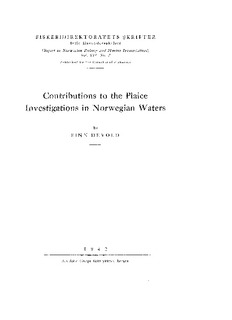| dc.description.abstract | The plaice-fishery has occupied a very humble place among the
Norwegian fisheries up to 20 years ago, when it began to develop into
an important industry. The reason first of all is to be found in the rapid.
development of the fresh-fish export in the last two decades, next it
is a consequence of the Danish seine being widely introduced also among
Norwegian fishermen.
The marking experiments made on plaice in Norwegian waters
seem to suggest that the plaice on the coast banks are comparatively
mobile, whereas the stock of the fjords are more stationary. The reason
is probably to be found in the topographical features of the bottom.
Deeps of more than 200 m constitute no absolute hindrance on the movements
of the plaice, but seem to be very restrictive. SOOT-RYEN'S
marking experiment in North-Norway show that the drift of eggs and
larvae in pelagic stages is compensated by the tendency of older individuals
to move actively in the opposite direction.
The morphological characters suggest that the same race is found
along the Norwegian coast froni Jæren to Tana, but the stock of the
Trondheim Fjord shows an important deviation with regard to number
of anal fin rays as well as to number of vertebrae.
The number of anal fin rays seem to be so much influenced by the
environment, that it must be doubted whether it is allowable for characterizing
plaice populations.
Also in Norwegian waters a segregation is going on withint the plaice
stock, as the quickest-growing individuals within a year-dass seek deeper
water at an earlier age than the more slow-growing.
The plaice stock of the Trondheim Fjord has a very high growthrate,
which has increased very much during the years 1935-38.
The winter rings of the interoperculum, which show distinctly
the dose of each year of life may probably be used for computing the
total length of plaice in its different years of life.
The otoliths as well as the interoperculum seem to reveal the age
of a plaice at the onset of maturity. On the basis of such, we may,
in the same way as GUNNAR ROLLEFSEN has done for the skrei, divide
the mature portion of the plaice stock into spawning-dasses and spawninggroups.
From these may be computed the mortality, using LEA'S
formula. In the case of male plaice in the Sundnes area in the Trondheim
Fjord it was found to be 54 %, the females 23 %.
The age-composition and the relative increase or decrease of the
mature stock have been computed one year in advance from the number
of spawning-zones, and the age-compositions thus computed show a
good agreement with the observed compositions. As regard this, the
year 1939 makes, however an exception. It is the first time spawners
which do not enter the mature stock in analogy with the older yearclasses. | |
